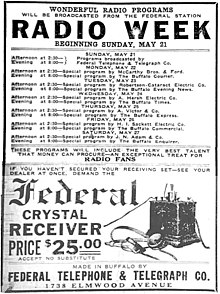WGR
Owned by Audacy, Inc., its studios and offices are located on Corporate Parkway in Amherst, and the transmitter site—used by WGR and co-owned WWKB—is in Hamburg.
[5] The Buffalo Courier and Enquirer was issued a temporary authorization for 360 meters, with the call sign WPU, for a January 22, 1922, concert.
[9] The March 28 issue of the Buffalo Evening News reported hearing test transmissions made by WGR the previous night.
[10] On April 1 it was announced that, starting that day, WGR would broadcast weather reports provided by the Department of Navigation on 485 meters each weekday at 12:30 and 6:00 pm.
F. Hyatt Smith, Kenmore Presbyterian Church speaking about the nature of "success", and Albert Kinsey, Chamber of Commerce president, reviewing the financial future of Buffalo.
[18] In September 1922 the Department of Commerce set aside a second entertainment wavelength, 400 meters (750 kHz) for "Class B" stations that had quality equipment and programming.
[21] Effective November 11, 1928, the recently formed Federal Radio Commission implemented its General Order 40, which divided transmitting frequencies into three categories: Clear Channel, Regional and Local.
[23] The August 1941 adoption of the Federal Communications Commission's "duopoly" rule restricted licensees from owning more than one radio station in a given market,[25] and the Buffalo Broadcasting Company decided to divest WGR, while retaining WKBW.
In 1987, Taft sold WGR and WRLT (the former WGRQ) to Rich Communications, which was part of the Robert Rich family's business holdings, which also included a major processed-food company (and with it, naming rights for the Buffalo Bills stadium then (now called Highmark Stadium) and a venture applying for a National League expansion baseball franchise (for which WGR was projected to be flagship station of the team's projected network).
Although the Rich interests were the National League's choice for the new franchise they dropped out of the competition for an expansion team set to begin play in 1993 (which ultimately went to Denver, as the Colorado Rockies) for cost reasons.
The Bills' four consecutive Super Bowl seasons were broadcast by WGR, whose Program Directors included Chuck Finney (1991–1993), Daryl Parks (1993–1995) and Jim Pastrick (1995–2000).
Through its news-talk era the WGR line-up featured a variety of programs such as Breakfast with Bauerle (Tom Bauerle), The Fabulous Sports Babe, Chuck Dickerson, Art Wander, Extension 55 with John Otto, Ron Dobson, John and Ken, Rick Emerson, Joey Reynolds, and several other local and national hosts.
Anne Burke, a frequent caller to the station's talk shows, joined Bob Gaughan to co-host middays.
From October 2000 to 2004, WGR competed with WNSA-FM, an FM station licensed to Wethersfield, New York, in rural Wyoming county (with a 107.3 translator in Buffalo).
WGR landed a coup when it signed WNSA's top afternoon host, Mike Schopp, from WNSA-FM in 2002; the event came at about the same time as when John Rigas and Adelphia Communications were beginning to collapse under massive financial scandal.
Bauerle moved from WGR to sister station WBEN, Gaughan joined Kevin Sylvester in morning drive (Burke had been released long before this).
Riter was paired with sidekick Jeremy White in the evening and lastly The Tony Kornheiser Show (from ESPN) was added in Gaughan and Burke's old time slot.
In January 2008, Williams was hired as the new evening host at WGR; WIVB declined to his contract shortly thereafter, and replaced him with Murphy.
[28] In 2012, WGR secured the rights to the Buffalo Bills Radio Network after previous owner WGRF decided against renewing their contract.
At the same time, Kevin Sylvester also returned to the station as the host of a daily Sabres-oriented talk show, Hockey Hotline, which last aired in 2004.


